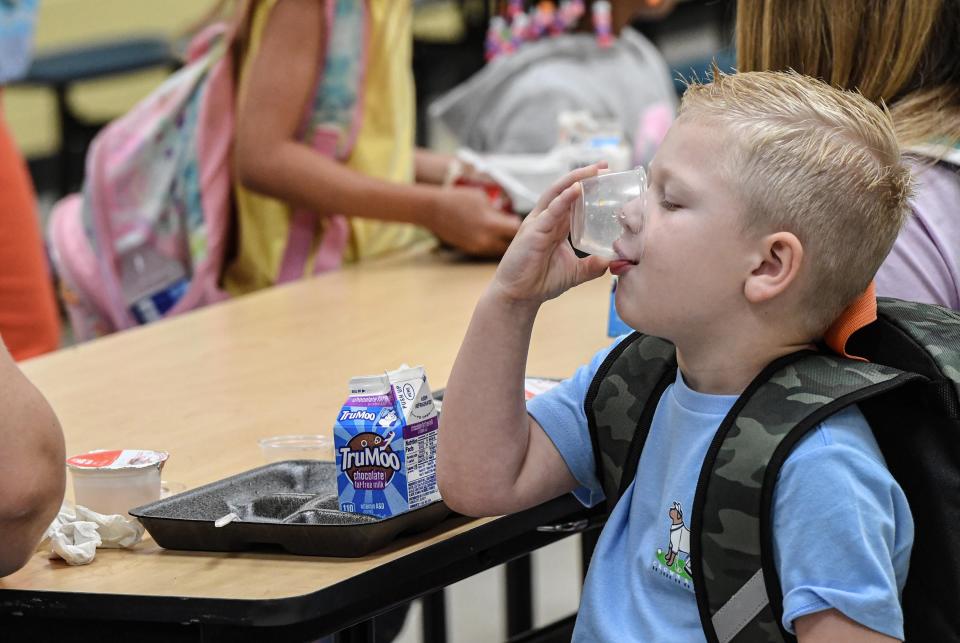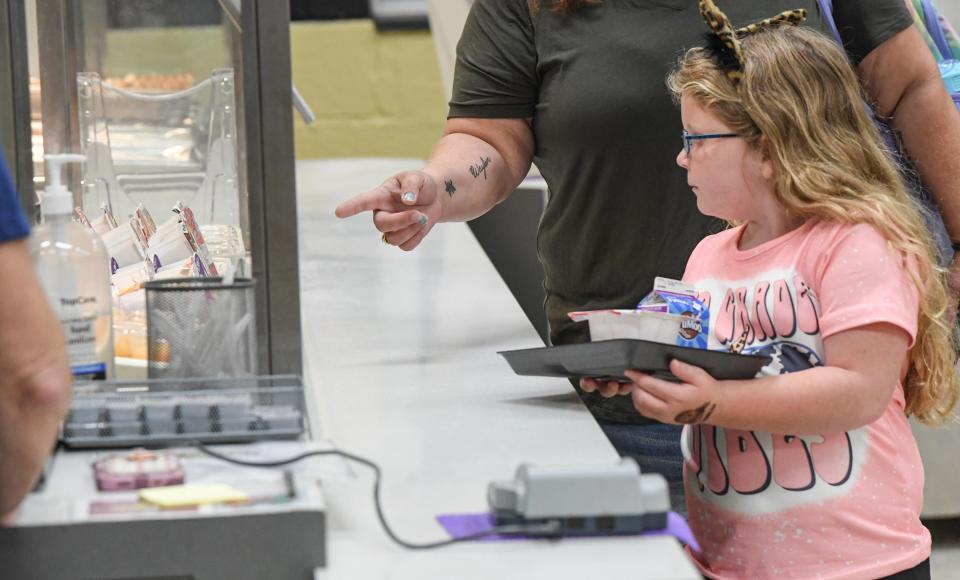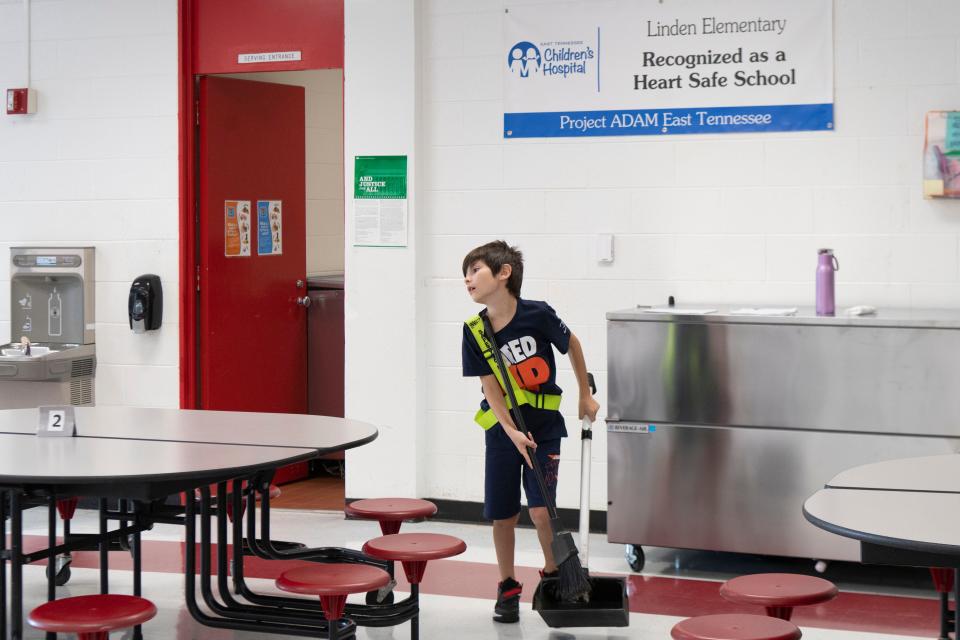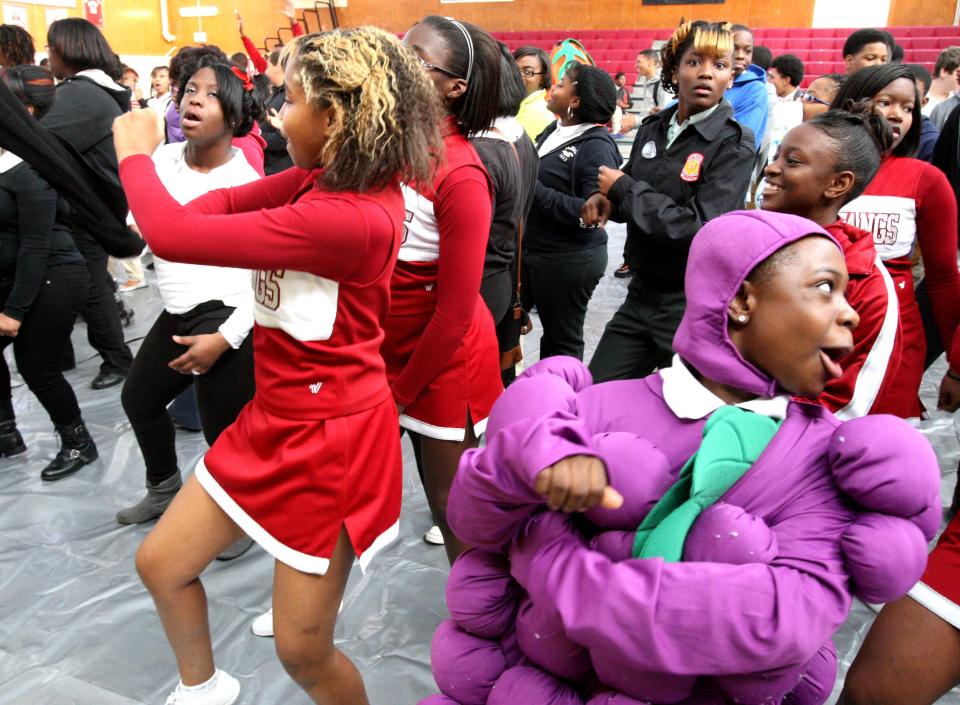School lunch 101: Your guide to the key questions and controversies
Every weekday, kids have to eat during school hours. And there is an army of parents and cafeteria workers making that happen.
Cafeteria meals — not just lunch but often breakfast and after-school snacks — are a huge undertaking. Pre-pandemic, school cafeterias served lunch to close to 30 million students per day, according to the School Nutrition Association. The federal government paid almost $19 billion for school breakfast and lunch, including buying $1.3 billion in commodities from American farmers.
And that’s only about 56% of students, going by federal enrollment figures. Bringing lunch is still very popular.
As school starts up again, here’s your guide to the key questions and controversies. Read on for ...
Are school meals still free?
Is school lunch healthy?
How do I know if the cafeteria is following food safety rules?
What about allergies?
My kid is a vegetarian
Do kids like cafeteria lunch?

Are school meals still free?
It depends. During COVID, Congress authorized funding for universal free school lunch. That program is over. But schools with a significant share of low-income students (40% or more) can still offer universal free meals if they apply for a waiver. And some districts allocated money to continue universal free meals.
All public school students eat free this year in Asheville, North Carolina; Greenville, South Carolina; Jackson, Mississippi; Memphis and Nashville. It varies by school in Fayetteville, North Carolina; Knoxville, Tennessee; and Wilmington, North Carolina.
We’ve linked to webpages where you can check.
No matter what their school does, any eligible family can apply for a meal subsidy. As of fall 2021, more than 40% of public school students qualified, according to the National Center for Education statistics.
Here are the income limits for 2023-24. If a family member loses a job, you can apply partway through the term.
Free and subsidized school meals remain an important anti-poverty program. One in eight U.S. children lives in a household that sometimes doesn’t have enough to eat, including one in five Black children, according to Feeding America. When schools closed for COVID-19, getting meals to kids was one of the first priorities.
Where school meals aren’t free, they aren’t expensive. Williamson County, Tennessee, schools are charging $3.75 for lunch this year, according to the district website.
Is school lunch healthy?
Healthy “is a loaded term for me. Because it means so many different things to different people,” said Raleigh dietitian Anna Lutz, who has three children in public school.
She hears the “concern that the food is too processed,” she said. “That it’s too much sugar, it’s quote-unquote junk food.”

However, school meals must meet federal nutrition guidelines. Since Michelle Obama took up the cause, they have more whole grains, lower sodium and lower fat. The Department of Agriculture is currently considering lowering sodium further and adding limits on sugar.
Nutritionally, they stand up well against the competition. Several studies found that home-packed lunches typically had less fruit, vegetables and dairy, and more sugar-sweetened drinks, desserts and snacks.
Lutz praises the variety. For instance, August offerings at Chadwell Elementary in Madison, Tennessee, included Israeli rice and beans, steamed broccoli, chicken–salsa verde tamales and vegetable soup with spicy grilled cheese.
Making lunch at home, “I’m going to get in a rut,” Lutz said. If the parent is less stressed about the need to squeeze packing lunch into the schedule, “That’s a healthy thing, too.”
If a parent is concerned about school lunches, they can bring it up with administration. “Tell us what you like and what you don’t like,” said Spencer Taylor, Metro Nashville Public Schools nutrition director.
How do I know if the cafeteria is following food safety rules?
School cafeterias get inspected, like restaurants. Find reports online at the following sites:
North Carolina: look on the county health department webpage
Tennessee (look for “food service”)

If your child brings lunch, the Partnership for Food Safety Education has the following food safety guidelines:
Wash your hands before making or eating the lunch.
Keep perishable items chilled with two cold sources (such as an ice pack and a frozen drink box) in an insulated tote.
Store the lunch in a classroom fridge or at least out of the sun and away from heaters.
Throw away all used food packaging and unfinished, perishable leftovers.
What about allergies?
“Schools are very used to dealing with this,” School Nutrition Association spokeswoman Diane Pratt-Heavner said. The Americans with Disabilities Act requires schools “to accommodate any child with a medically documented allergy.” Often the school nurse gets involved.
Taylor’s team can identify dishes to avoid certain allergens, and even make sure the kid buys them instead of copying friends. There’s a dietitian to work with students who have complex needs. “We’ve seen everything at least twice,” he said.
My kid is a vegetarian
Vegetarian options are becoming more common in cafeterias, Pratt-Heavner said. At the School Nutrition Association's July conference, “one of the biggest trends on our exhibit floor was plant-based options.”
Even in the smallest district in Alabama, Linden City Schools, there’s no formal vegetarian option but “there’s an array of things to eat,” superintendent Timothy Thurman said.
More: Get to know the school lunch puzzle — and the workers who solve it each day
Do kids like cafeteria lunch?
Sometimes yes, sometimes no. And a lunch isn’t healthy if kids don’t eat it.
“What I run up against is my children not wanting to buy the school lunch,” Lutz said. “Some of it’s not appealing.”
Participation in school lunch dropped last year in Nashville. “We’re studying that and we’re trying to figure out why,” Taylor said.
Branding matters, as does appearance. Some students want to spend their limited lunch minutes sitting with friends instead of going through the line.
But flavor is king, and cafeterias have some challenges. First, those nutrition limits. “There are all these baked foods that would taste better fried,” Lutz observed, like tater tots and French, er, fries.
With whole-grain crusts, low-fat cheese and lower-sodium sauces and toppings, even pizza has dropped in popularity, Taylor said.
Second, home influences the palate. Metro Nashville families speak more than 100 languages. The cafeterias try to infuse international flavors into what they serve, but it’s never going to be as authentic.
On the other hand, while Taylor loves to see “greens and colorful vegetables and fruits,” if children don’t eat salads or less-sweet vegetables at home, “they’re a hard sell in schools,” he said.
School food teams are in the customer-service business. They want students to enjoy the food. And they get federal reimbursement only when kids take a meal.
Taylor thinks kids and parents should give school lunch a try. “We can offer convenience, we can offer nutrition,” he said. “We’ve got some good cooks and some people who love what they do.”
Bring or buy?
Among some wealthier families, this debate has gone round and round. Instagram can make it look like good parents (really: good moms) pack cute bento boxes with a rainbow of attractively pared produce. A 2019 article for The Kitchn is titled, “My Kid Buys School Lunch — Don’t Judge.”
In response, advocates point to the benefits of families buying lunch when they have the option not to. It can ease the parenting load, reduce the stigma of eating cafeteria food, fund better ingredients and increase wages for cafeteria workers, who are mostly women.
School lunch programs are expected to pay for themselves. Federal reimbursements don’t cover the full costs and expenses are up, according to the School Nutrition Association.
You don’t have to make an all-or-nothing decision: Kids can look at the menus and decide if they want to buy lunch some days.
If you pack a lunch, Lutz suggests shelving the Instagram “shoulds” and making it easier. Here’s her recipe:
Come up with a few easy entrees you know your kid will enjoy — even just two or three. Or make extra helpings of dinner the night before.
Add a side, some produce and something sweet.
Then “call it a day. It’s not a reflection on your parenting,” she said.
Danielle Dreilinger is an American South storytelling reporter and the author of the book “The Secret History of Home Economics.” You can reach her at ddreilinger@gannett.com or 919/236-3141.

This article originally appeared on Nashville Tennessean: School lunch 101: Your guide to the key questions and controversies

